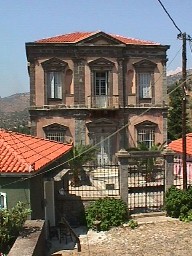The Traditional Village of Vatousa
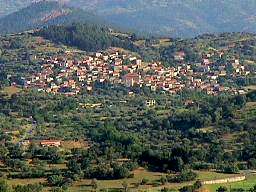 Vatousa is one of
the five villages of Lesvos whose identity as a
traditional village is protected by law. The village
was first settled in the 10th century and probably
takes it's name from the word meaning ‘area rich in
berries', or perhaps according to another
interpretation from a word which means "the accessible
one".
Vatousa is one of
the five villages of Lesvos whose identity as a
traditional village is protected by law. The village
was first settled in the 10th century and probably
takes it's name from the word meaning ‘area rich in
berries', or perhaps according to another
interpretation from a word which means "the accessible
one".
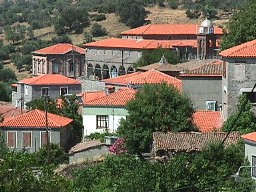 The visitor to
the village will immediately notice and admire the
architectural features which have gained
protected status. The stone-paved streets and
walls and the impressive stone houses with
ceramic-tiled roofs provide a link to the past
which will remain permanent.
The people of Vatousa
follow informal conventions which enhance it's
unique local character, retaining the flora of
their gardens and general surroundings in fine
condition, adding more character to the village in
a tasteful and authentic way. This suggests that
village life within Vatousa is also respectful of
tradition as the activity in the central square
might make evident. Vatousa is profoundly
traditional without being self-consciously
antiquated or
quaint.
The visitor to
the village will immediately notice and admire the
architectural features which have gained
protected status. The stone-paved streets and
walls and the impressive stone houses with
ceramic-tiled roofs provide a link to the past
which will remain permanent.
The people of Vatousa
follow informal conventions which enhance it's
unique local character, retaining the flora of
their gardens and general surroundings in fine
condition, adding more character to the village in
a tasteful and authentic way. This suggests that
village life within Vatousa is also respectful of
tradition as the activity in the central square
might make evident. Vatousa is profoundly
traditional without being self-consciously
antiquated or
quaint.
There is much to see
in the village but the visitor should not neglect
to visit the Gogos Mansion, whose particular
placement makes it a dominant structure in the
village, and whose nineteenth century neoclassical
style matches certain of the Mytilini mansions of
the same
period.
The building is maintained by the Vatousans as a
small museum and has become a tourist attraction.
It houses a library of two rare collections, a
museum of local arts and crafts, a lending
library, and an exhibit of photographs which
document past life in Vatoussa and includes a
partial record of Vatousa's emigres to other parts
of the world.
The Gogos Mansion
also includes bound volumes of a newspaper devoted
to Vatoussa's concerns, The Pulse of Vatousa,
edited and published in Athens by Yannis Manoukos
and the Society of All
Vatousans.
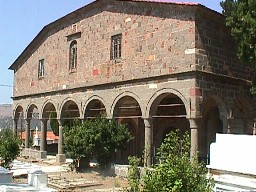 Of particular
interest within the village are Vatousa's two
churches. The older of the two, The
Church of the
Archangels, dates from 1832 and is a
three-aisled basilica, a construction reminiscent
of the Patriarchate of Constantinople, and common
to the Eastern Aegean. The interior of the church
is decorated with folk art. The church itself is
located in the village cemetery which has unusual
vaulted tombs still in use.
In a corner of the
cemetery are two buildings, one old and the other
new, where wooden boxes contain the remains of the
village deceased.
Of particular
interest within the village are Vatousa's two
churches. The older of the two, The
Church of the
Archangels, dates from 1832 and is a
three-aisled basilica, a construction reminiscent
of the Patriarchate of Constantinople, and common
to the Eastern Aegean. The interior of the church
is decorated with folk art. The church itself is
located in the village cemetery which has unusual
vaulted tombs still in use.
In a corner of the
cemetery are two buildings, one old and the other
new, where wooden boxes contain the remains of the
village deceased.
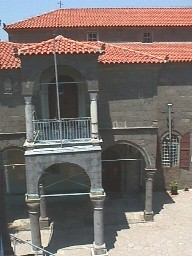 The more
recent church, The Central Church of the Dormition
of the Virgin, was built in 1850 of hand hewn
stone and is of the same style. The iconostasis of
carved wood contains fine examples of
post-Byzantine iconography. In the church
courtyard there is an ecclesiastical museum which
houses some interesting Byzantine relics.
Also noteworthy in
the platia is the bell tower which can give you a
vantage point of the entire lower village and the
valley, hills and mountains beyond. Depending upon
when you look at it, this clock tells the correct
time and it's bell strikes loud and dramatically
on the hour and half hour and can be quite
startling if you are standing next to them
enjoying the view. You will also notice the
small cathedral for the more spiritual birds of
the village built on the wall of the
church.
The more
recent church, The Central Church of the Dormition
of the Virgin, was built in 1850 of hand hewn
stone and is of the same style. The iconostasis of
carved wood contains fine examples of
post-Byzantine iconography. In the church
courtyard there is an ecclesiastical museum which
houses some interesting Byzantine relics.
Also noteworthy in
the platia is the bell tower which can give you a
vantage point of the entire lower village and the
valley, hills and mountains beyond. Depending upon
when you look at it, this clock tells the correct
time and it's bell strikes loud and dramatically
on the hour and half hour and can be quite
startling if you are standing next to them
enjoying the view. You will also notice the
small cathedral for the more spiritual birds of
the village built on the wall of the
church.
 Two more
buildings are worthy of attention. One is the old
Finishing School for Young Women, unique in it's
time which today serves as a hostel. The other is
the once-renowned Vatoussa School for Boys, near
the cemetery, in use today as an elementary
school.
Two more
buildings are worthy of attention. One is the old
Finishing School for Young Women, unique in it's
time which today serves as a hostel. The other is
the once-renowned Vatoussa School for Boys, near
the cemetery, in use today as an elementary
school.
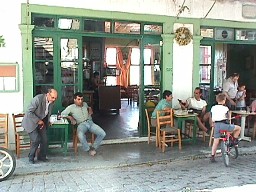 The upper part
of the village has a cobblers shop, two barber
shops, and three cafes which are no less
traditional and still very much in operation. Ouzo
is still served in the traditional way, with
mezedes, small snacks that lessen the effects of
the alcohol, providing a sense of well-being
rather then drunkenness. They also serve meals
from an unwritten menu that varies from day to day
but is always delicious.
Tryphon's, shown
here, is a popular meeting place in the morning
when the men drink coffee and watch for the fresh
produce trucks that make the rounds through the
villages selling fish, fruits and
vegetables.
The upper part
of the village has a cobblers shop, two barber
shops, and three cafes which are no less
traditional and still very much in operation. Ouzo
is still served in the traditional way, with
mezedes, small snacks that lessen the effects of
the alcohol, providing a sense of well-being
rather then drunkenness. They also serve meals
from an unwritten menu that varies from day to day
but is always delicious.
Tryphon's, shown
here, is a popular meeting place in the morning
when the men drink coffee and watch for the fresh
produce trucks that make the rounds through the
villages selling fish, fruits and
vegetables. 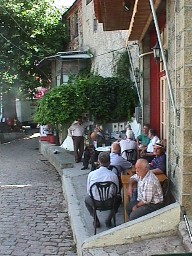 He is famous for his cooking, much of which is
done by his wife at home and then brought to the
cafe before lunch. The view of the valley from the
very large window is spectular and the interior
remains untouched and looks as it has for a
hundred years. Across the street is another
cafeneon where Michali and his father, who also
own the woodworking shop next door, serve
excellent mezedes. Though the cafe itself has a
somewhat more modern look to it, the atmosphere is
still very traditional, despite the occasional
World Cup match or basketball game being shown on
TV.
He is famous for his cooking, much of which is
done by his wife at home and then brought to the
cafe before lunch. The view of the valley from the
very large window is spectular and the interior
remains untouched and looks as it has for a
hundred years. Across the street is another
cafeneon where Michali and his father, who also
own the woodworking shop next door, serve
excellent mezedes. Though the cafe itself has a
somewhat more modern look to it, the atmosphere is
still very traditional, despite the occasional
World Cup match or basketball game being shown on
TV.
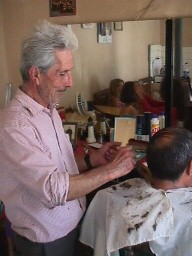 The barbers
practice an art that has a has been lost in
modern society, using a straight razor and
traditional barbers methods with a sensitivity
that is rare. A simple shave can be a relaxing,
thoughtful and enlightening experience that may
make you want to change your grooming habits
forever.
A shave costs around a dollar. A haircut may cost
you as much as two dollars and a shave and haircut
together will cost almost three. The barbershop is
a popular place to get the news of the village as
well as what goes on in the world
outside.
The barbers
practice an art that has a has been lost in
modern society, using a straight razor and
traditional barbers methods with a sensitivity
that is rare. A simple shave can be a relaxing,
thoughtful and enlightening experience that may
make you want to change your grooming habits
forever.
A shave costs around a dollar. A haircut may cost
you as much as two dollars and a shave and haircut
together will cost almost three. The barbershop is
a popular place to get the news of the village as
well as what goes on in the world
outside.
There are several shops in the upper village including two ‘super-markets' which are actually small food stores, a ‘pandapoleion' which means literally ‘store that sells everything'. A visit to this store will reveal products that may have have been sold in this shop and others like it for a hundred years. There is a butcher shop that sells fresh meat including beef, chicken, pork, sheep and goat. The butcher uses a giant chopping block which is actually the trunk of a tree.
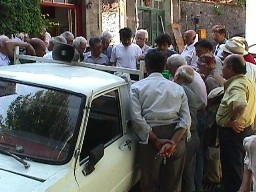 Most of the
fresh produce and fish is sold off trucks that go
from village to village. While the vegetable and
fruit trucks pass through town several times a
day, the fish trucks are less frequent and
sometimes seem to have made Vatousa the last stop.
This is because the villagers are known for being
tough customers who are more likely to gather
around the truck and make jokes about the fish
then they are to buy any. Even so when a truck
arrives with fresh sardeles, kolios or gopa,
Tryphon is quick to buy and a few minutes later,
fried in olive oils it appears on a customer's
plate.
Most of the
fresh produce and fish is sold off trucks that go
from village to village. While the vegetable and
fruit trucks pass through town several times a
day, the fish trucks are less frequent and
sometimes seem to have made Vatousa the last stop.
This is because the villagers are known for being
tough customers who are more likely to gather
around the truck and make jokes about the fish
then they are to buy any. Even so when a truck
arrives with fresh sardeles, kolios or gopa,
Tryphon is quick to buy and a few minutes later,
fried in olive oils it appears on a customer's
plate.
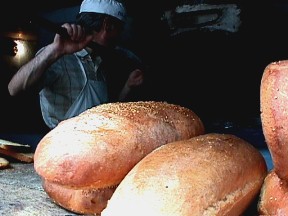 There are two
bread shops in the
village including the small one on the steps
leading up from the main platia which sells
traditional bread, baked in traditional methods in
an oven heated by wood. The villagers buy their
bread through the window, as well as
tiropitas(cheese pies), paxemadia (a hard bread
that is softened in water or milk) and
koulourakia(donut shaped bread).
The second bread shop
is located on the street behind the main church in
a basement under Mario and Michali's Supermarket.
The bakery is so small and the large oven takes up
so much space that the upper part of the door
remains open not only so people can purchase their
bread from outside the store (which can get very
hot) but so the baker has room to work without the
giant wooden spatula hitting walls and
windows.
There are two
bread shops in the
village including the small one on the steps
leading up from the main platia which sells
traditional bread, baked in traditional methods in
an oven heated by wood. The villagers buy their
bread through the window, as well as
tiropitas(cheese pies), paxemadia (a hard bread
that is softened in water or milk) and
koulourakia(donut shaped bread).
The second bread shop
is located on the street behind the main church in
a basement under Mario and Michali's Supermarket.
The bakery is so small and the large oven takes up
so much space that the upper part of the door
remains open not only so people can purchase their
bread from outside the store (which can get very
hot) but so the baker has room to work without the
giant wooden spatula hitting walls and
windows.
The upper platia is worth a trip just by itself. Shaded by a remarkable Platanos tree which actually has a very large fig tree growing out of the middle of it, this is indeed a miracle of nature. These trees are home to families of owls. In the early summer many of the young fall from their nest and land in the platia where they are rescued by locals and cared for until they are old enough to fly away and care for themselves. In the evenings you can hear them sing back and forth to each other, with their distinctive cries.
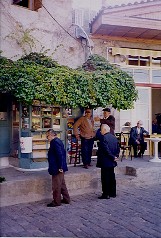 In between the
two cafeneons is one of the most interesting
peripteros in all of Greece. From this little
rectangular free standing store, Mr. Vassilis
sells cigarettes and other neccessities of village
life until the late evening when he retrieves his
donkey and makes his way up the mountain to his
house at the top of the village. Many of the men
who own shops or have day jobs, wake up early to
tend to their flocks, fields and gardens before
coming to work in what is known as the
agora or
marketplace.
In between the
two cafeneons is one of the most interesting
peripteros in all of Greece. From this little
rectangular free standing store, Mr. Vassilis
sells cigarettes and other neccessities of village
life until the late evening when he retrieves his
donkey and makes his way up the mountain to his
house at the top of the village. Many of the men
who own shops or have day jobs, wake up early to
tend to their flocks, fields and gardens before
coming to work in what is known as the
agora or
marketplace.
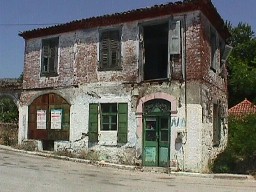 In the lower
platia on the main road between Erressos and
Mytilini there is the remains of a Turkish Hania,
or guest house that is currently being restored
and will be re-opened. This building overlooks the
tiny square which is a popular gathering place for
people not only from Vatoussa, but the other
nearby villages of Pterounda, Remma, and Xidera.
One might attribute the popularity of the area to
the fact that it is one of the few places in the
village where there is actually room to park a car
or two.
In the lower
platia on the main road between Erressos and
Mytilini there is the remains of a Turkish Hania,
or guest house that is currently being restored
and will be re-opened. This building overlooks the
tiny square which is a popular gathering place for
people not only from Vatoussa, but the other
nearby villages of Pterounda, Remma, and Xidera.
One might attribute the popularity of the area to
the fact that it is one of the few places in the
village where there is actually room to park a car
or two.
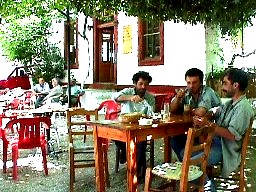 There are two
restaurants including Michali's which is a meeting
place bringing together the villagers and
travelers on the main road. Open all day long and
late into the evening, he serves delicious grilled
meats and vegetable dishes all cooked by his
mother and served by his family. Like the
traditional cafeneons above he also serves ouzo
and mezedes by the glass or the
carafe.
There are two
restaurants including Michali's which is a meeting
place bringing together the villagers and
travelers on the main road. Open all day long and
late into the evening, he serves delicious grilled
meats and vegetable dishes all cooked by his
mother and served by his family. Like the
traditional cafeneons above he also serves ouzo
and mezedes by the glass or the
carafe.
Among the different trades practiced by the people of Vatousa there are carpenters, various types of stone masons, electricians, farmers, shephards, a butcher, shop owners and a priest or two. There are many old people who have returned after living abroad and now spend their days farming or talking in the cafeneons. Others have been here since birth. There are also many Athenians who originally came from the village and now return for summer holidays making it a very festive time.
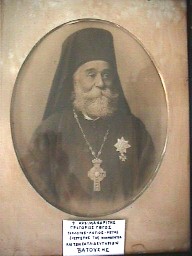 Vatoussa is
the birthplace of many prominent persons among
whom the Archimandrate Gregorios Gogos who was a
theologian, Ioannis Taxis, a professor of Greek
and Philosophy at the school of Halki and Antonios
Harilos, a professor of Greek at the Greek Academy
of Constantinople, were notable scholars. Also
born in Vatousa was Ignatios Ekonomides who in the
beginning of the 20th century was bishop of the
Greek Orthodox Church in Erseka (Albania) and who
later became the Archbishop of the Greek Orthodox
Church in Bosnia and Herzegovina. Iakovos
Anastasiades, was the highly respected director of
the aforementioned School for boys. His children
also distinguished themselves as journalists.
Doros Doris (Theodore Theodorides), a
multi-talented writer and musician is best known
as a surrealist poet of the literary period called
‘the Lesbian Spring' and published the first
newspaper on the island. Not least of course there
is movie producer James Paris (Dimitris
Paraschakis) whose father taught school in Vatousa
and has been among the villages most important
benefactors.
Vatoussa is
the birthplace of many prominent persons among
whom the Archimandrate Gregorios Gogos who was a
theologian, Ioannis Taxis, a professor of Greek
and Philosophy at the school of Halki and Antonios
Harilos, a professor of Greek at the Greek Academy
of Constantinople, were notable scholars. Also
born in Vatousa was Ignatios Ekonomides who in the
beginning of the 20th century was bishop of the
Greek Orthodox Church in Erseka (Albania) and who
later became the Archbishop of the Greek Orthodox
Church in Bosnia and Herzegovina. Iakovos
Anastasiades, was the highly respected director of
the aforementioned School for boys. His children
also distinguished themselves as journalists.
Doros Doris (Theodore Theodorides), a
multi-talented writer and musician is best known
as a surrealist poet of the literary period called
‘the Lesbian Spring' and published the first
newspaper on the island. Not least of course there
is movie producer James Paris (Dimitris
Paraschakis) whose father taught school in Vatousa
and has been among the villages most important
benefactors.
Current inhabitants of the village include the famous Dramatic Soprano Ioanna Sfekas-Karvelas whose arias can be heard each morning while she practices from her home near the upper platia.
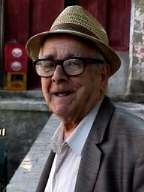 Vatousans are
proud of their heritage and of the traditional
identity of their village which they are
determined to respect and to retain. They extend a
hearty welcome to others who appreciate this
tradition, to come and
visit.
Vatousans are
proud of their heritage and of the traditional
identity of their village which they are
determined to respect and to retain. They extend a
hearty welcome to others who appreciate this
tradition, to come and
visit.
If you have not done so already visit these pages too:
- The Gogos Mansion and Museum
- The Heart of Vatousa
- Bread shops
- Church of the Archangels
- Village Life
-
Village Landscape and
Buildings
